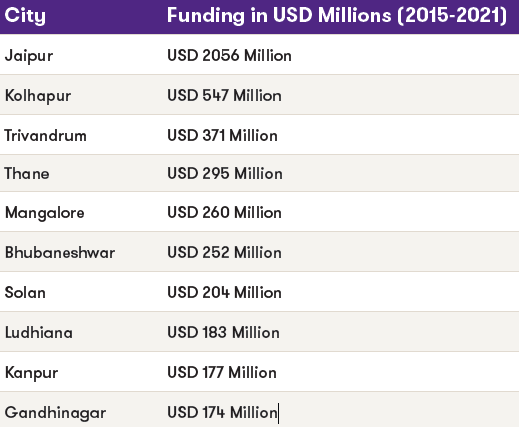-
Digital Natives
Unlock growth with Grant Thornton Bharat's Digital Natives solutions. Customised support for tech-driven companies in healthcare, gaming, and more.
-
Business Consulting
Our business consulting specialists offer a comprehensive blend of strategic advisory services. We assess the business, industry, operating model, synergy, skill sets and vision of the organisation and recommend the way forward
-
Digital Transformation Services
Grant Thornton’s digital transformation services help traditional businesses digitalise their business models with cloud technology, IoT consulting, app development and more DigiTech solutions.
-
Human Capital Consulting
Our Human Capital Consulting team harnesses technology and industry expertise to assist in constructing adaptable organisations with transparency, fostering productive and value-driven workforces, and inspiring employees to engage meaningfully in their tasks.
-
Production Linked Incentive Scheme
Production-linked Incentive Scheme by the Indian government is aimed at boosting manufacturing. Grant Thornton Bharat offers varied services across sectors to help businesses avail of this scheme.
-
Public Sector Advisory
Our Public Sector Advisory team has focused streams, aligned with the core priorities of the Government of India. We are responsible for providing innovative and customized technical and managerial solutions.
-
Tech Advisory
We have amalgamated Digital Transformation, IT Advisory & Information Management and Analytics into a new offering, DigiTech.
-
Direct Tax services
Our tax specialists offer a comprehensive blend of tax services, tax litigation, regulatory and compliance services, helping you navigate through complex business matters.
-
Indirect Tax Services
Get tax services by leading tax firm Grant Thornton India. Our indirect tax services include consulting, compliance and litigation services for corporate, international and transaction tax
-
Transfer pricing services
Our transfer pricing services experts provide a range of services from provision of APA services to handling large global assignments including Country by Country reporting.
-
US Tax
At Grant Thornton, we help individuals and dynamic companies deal with US tax laws, which are one of the most complicated tax legislations across the world.
-
Financial Services - Tax
Best financial advisory services, tailored for small and large businesses by the experts having comprehensive knowledge of domestic laws and access to multifaceted tools to provide a valuable results.
-
Financial Reporting consulting services
Our experts have significant hands-on experience in providing IFRS/US GAAP services, end-to-end solutions and support services to fulfil financial reporting requirements.
-
Fund accounting and financial reporting
International operations often lack standardisation and have varied local reporting formats and requirements. Our experts can offer proactive insights, practical guidance, and positive progress and help meet regulatory timeframes.
-
Compliance and Secretarial Services
Our experts can assist in overhauling the entire compliance machinery of the organisation through evaluation of the applicable statutory obligations, monitoring of adequate governance controls, reporting and providing ongoing support.
-
Global People Solutions
As businesses transcend borders, both domestic and global considerations need equal attention. Our interim CFO and financial controller support services help organisations meet the business vision.
-
Finance and accounting outsourcing
Our accounting experts assist organisations in managing their accounting and reporting. Our dedicated Integrated Knowledge and Capability Centre (IKCC), allows us to service both the domestic and global markets efficiently and cost-effectively
-
Compliance Management System
We have automation solutions for you that will allow meeting government requirements and remain diligent, which when failed, can lead to penalties and loss in revenue.
-
IKCC: Grant Thornton's Shared Service Centre
The India Knowledge and Capability Centre (IKCC), aimed at delivering solutions by developing capabilities, has completed four years of its journey.
-
Global compliance and reporting solutions
At Grant Thornton Bharat, we meet the challenges of our clients and help them unlock their potential for growth. Our professionals offer solutions tailored to meet our clients’ global accounting and statutory reporting requirements. With first-hand experience of local reporting requirements in more than 145+ locations worldwide, we provide seamless and consistent international service delivery through a single point of contact.
-
Related Party Transactions Governance
Grant Thornton Bharat's comprehensive related-party transaction services ensure good governance by adhering to regulatory requirements, promoting transparency, and providing robust policies for compliance, documentation, and accountability in related-party transactions.
-
Private Client Services
Grant Thornton Bharat Private Client Services offers tailored advisory for family-owned businesses, focusing on governance, compliance, tax, succession planning, and family office structuring to sustain wealth and preserve legacies across generations.
-
GTMitra: Tax & Regulatory Tool
GTMitra, a specialised tax and regulatory tool by Grant Thornton Bharat, supports multinational businesses in understanding laws and regulations for effective growth strategies.
-
Labour codes
Labour codes solutions help you transition through the new legislation. At Grant Thornton, we help businesses divide their approach to make sure a smooth transition.
-
Alerts
At Grant Thornton India, with the help of our tax alerts, we help to provide updates on how to minimise your tax exposure and risks.

-
Cyber
In today’s time, businesses have gone through large transformation initiatives such as adoption of digital technologies, transition to cloud, use of advanced technologies et al.
-
Governance, Risk & Operations
Our Governance, Risk and Operations (GRO) services encompass Internal Audit, Enterprise Risk Management, Internal Financial Controls, IT advisory, Standard Operating Procedures and other services.
-
Risk analytics
Grant Thornton Bharat’s CLEARR Insights is a state-of-the art data analytics platform that will help you in seamless data analysis and efficient decision-making.
-
Forensic & Investigation Services
The team of forensic advisory services experts consists of the best intelligence corporate experts, and fraud risk, computer forensic experts to deliver most effective solutions to dynamic Indian businesses.
-
ESG consulting
Grant Thornton Bharat offers holistic ESG consulting solutions for sustainable business outcomes. With industry expertise and AI technology, we drive long-term value.

-
Transaction Tax Services
Our transaction tax experts understand your business, anticipate your needs and come up with robust tax solutions that help you achieve business objectives ensuring compliance and efficiency
-
Deal Advisory
Unlike other M&A advisory firm in India, we offer deal advisory services and work exclusively with controlled and well-designed strategies to help businesses grow, expand and create value.
-
Due Diligence
Grant Thornton’s financial due diligence services are aimed at corporate looking for mergers and acquisitions, private equity firms evaluating investments and businesses/promoters considering sale/divestment.
-
Valuations
As one of the leading valuation consultants in India, Grant Thornton specializes in all the aspects of the process like business valuation services, financial reporting, tax issues, etc.
-
Overseas Listing
Overseas listing presents a perfect platform for mid-sized Indian companies with global ambitions. Grant Thornton’s team of experts in listings, work closely with clients during all stages.
-
Debt & Special Situations Solutions
Grant Thornton Bharat offers specialist debt and special situations consulting services, including restructuring, insolvency, and asset tracing solutions.
-
Financial Reporting Advisory Services
Grant Thornton Bharat Financial Reporting Advisory Services offer end-to-end solutions for complex financial requirements, including GAAP conversions, IPO support, and hedge accounting advisory, ensuring accurate financial reporting and compliance.
-
Financial Statement Audit and Attestation Services
Grant Thornton Bharat offers customised financial statement audit and attestation services, ensuring impeccable quality and compliance with global standards. Our partner-led approach, technical expertise, and market credibility ensure effective solutions for your business needs.

- Agriculture
- Asset management
- Automotive and EV
- Aviation
- Banking
- Education and ed-tech
- Energy & Renewables
- Engineering & industrial products
- FinTech
- FMCG & consumer goods
- Food processing
- Gaming
- Healthcare
- Urban infrastructure
- Insurance
- Media
- Medical devices
- Metals & Mining
- NBFC
- Pharma, bio tech & life sciences
- Real estate and REITs
- Retail & E-commerce
- Specialty chemicals
- Sports
- Technology
- Telecom
- Transportation & logistics
- Tourism & hospitality
-
 Article Sustainable farming and its economic imperativeSustainable farming in India is crucial for food security, economic growth, and environmental conservation, requiring government support and farmer education.
Article Sustainable farming and its economic imperativeSustainable farming in India is crucial for food security, economic growth, and environmental conservation, requiring government support and farmer education. -
 Article Agriculture and Budget: Immediate compulsions and long-term visionGovernment focuses on sustainable agriculture, digital infrastructure, and market intelligence to enhance productivity and global competitiveness in agriculture.
Article Agriculture and Budget: Immediate compulsions and long-term visionGovernment focuses on sustainable agriculture, digital infrastructure, and market intelligence to enhance productivity and global competitiveness in agriculture. -
 Article Union Budget 2024 expectations: Building resilience for consumer industryUnion Budget 2024 expectations: Building resilience for consumer industry
Article Union Budget 2024 expectations: Building resilience for consumer industryUnion Budget 2024 expectations: Building resilience for consumer industry -
 Thought Leadership Grain to gain: Impact of corn on India’s biofuel revolutionExplore Grant Thornton insights on unlocking India’s Energy Potential on Corn-Based Ethanol as a sustainable fuel solution.
Thought Leadership Grain to gain: Impact of corn on India’s biofuel revolutionExplore Grant Thornton insights on unlocking India’s Energy Potential on Corn-Based Ethanol as a sustainable fuel solution.
-
India-UK
India-UK
Just like all others, India has had its fair share of ups and downs during the pandemic inflected past 2 years. Despite that, as 2021 came to an end, the Indian economy stood tall on the international stage at a value of ~USD 2.8 trillion. One of the key drivers of this growth has been the robust activity seen in the start-up space in the country. The year gone by has been a landmark year, with India giving the world 44 unicorns, thereby ushering the country into its next phase of growth. Grant Thornton Bharat’s report, on Democratisation of the start-up ecosystem in Bharat, is an analysis of the rapidly-advancing and evolving start-up ecosystem in the country.
Grant Thornton Bharat's senior partner said, “A synergistic democratisation of the Indian start-up ecosystem has created a level playing field for entrepreneurs in India. From increasing accessibility to enhanced digital connectivity, technology has improved the overall efficiency in start-up evaluation and investment sourcing, thereby allowing the phenomenal growth witnessed last year, with a special contribution made by start-ups in Tier II, III and IV cities.”
According to Startup India, more than 60% of start-up related queries have been coming from Tier II and Tier III cities. Small towns have birthed unique businesses, which started off as regional players but have now grown to become recognisable brand names. A few of these are Eggoz (Bihar), Annaxee (Indore), Cardekho (Jaipur), Robosoft (Udupi) and Mindgrep (Dharamshala) etc.
Factors that have contributed to the growth of startups in Tier II-III-IV are:
- Operational efficiencies: 40% lower real estate costs, abundant access to talent and resources
- Novel business ideas: Emergence of Tier II and III as hubs that focus on solving novel ‘Bharat’ issues at grassroot levels
- Government Initiatives: 27 state governments launched specific initiatives, including boot camps, incubation networks and complementary working space
- Large consumer base: 70% of India’s population lives in Tier II and III
- Internet penetration: 825 million Indians have access to low-cost efficient internet, hyper-fast data availability in 650+ towns
- Angel investors and funds: Expanding geo-spatial reach of Angel Investors, Angel Funds, VCs and micro VCs, looking for growth beyond metros

In the recent past, the burgeoning angel networks have begun to capitalise on the collective wisdom, background and expertise of their individual member investors. As these networks tap into the growing opportunities in tier II, tier III and rural areas of the country; the budding entrepreneurs of India have actively leveraged upon the availability of funding and support in the creation of a new ‘Bharat’ and the move to becoming an economy of job creation.
